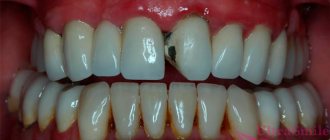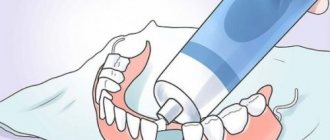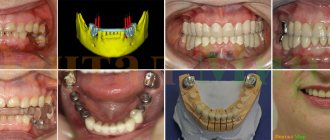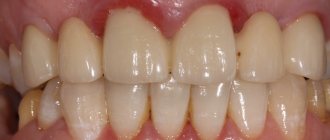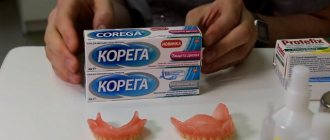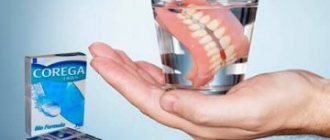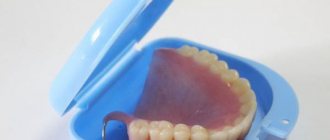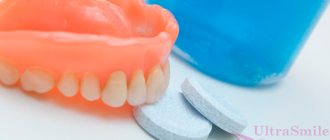The most common service in dentistry is prosthetics. If the dentist performs it correctly, a person’s teeth will become straight and their smile will be attractive. Since a large load is created on the jaw during chewing, situations may occur in which structural elements are damaged. You need to figure out how to fix a denture at home without resorting to the services of a dentist.
When to repair a structure
The materials in dentures are highly durable, but over time they can wear out or even break. Many people who use a prosthesis every day experience damage that requires emergency repairs.
There are the following reasons why device correction may be required:
- the crowns acquire a defective shade, for example, yellow or brown;
- the appearance of discomfort, pain, which previously did not bother the patient when using the structure;
- detachment, crack, puncture, peeling or other defects causing discomfort or loss of function;
- mechanical damage when clenching teeth, chewing hard elements.
If a breakdown occurs, it is better to contact your dentist directly so that he can repair the product without causing further defects. But there are times when immediate contact with a specialist is impossible. For example, if a person is away. Then temporary repairs can be done at home.
With mechanical damage and penetration of pathogenic microorganisms, the tissues of the oral cavity are quickly damaged. An inflammatory process develops, indicating the development of a pathological process. Read more in the article: “a pocket in the gum between the teeth - how to treat.”
It is important not to damage the structure yourself, since repairing it will cost much less than buying a new prosthesis. There may also be breakdowns that a person cannot handle, for example, if repairs require the use of specific medical instruments.
Main causes of damage
Defects on dentures occur for various reasons, which are associated with external influences or improper use. Repairing the damage depends on the specific cause.
Fall of the structure
Throughout the entire process of wearing removable dentures, you should avoid dropping them on a hard surface. Often the product is damaged as a result of hitting a tiled floor or sink during cleaning. A fall even from a small height can lead to the formation of chips and microcracks.
High load
To avoid damaging the structure, you should avoid eating hard and too hard foods, including crackers and nuts. Solid food increases stress on the product and causes defects.
Reducing the load can also be achieved by removing the prosthesis at night and storing it in a glass of water or in a damp cloth.
Damaging factors
The use of dentures is very convenient for people who have lost part of their teeth or the entire dentition. This is a life-saving design, thanks to which the chewing function is fully restored. If it is installed in a timely manner, there will be no defect in the soft tissues or jaw bones. After installation, the dentist warns about the following features:
- rules of daily care;
- possible types of defects for which you will need to seek help from a dentist;
- rules for installing and removing the structure.
A small defect or complete breakdown of a denture can happen at the most inopportune moment. this :
- end of service life;
- impact on various objects, hard surfaces, which occurs when removing or installing a prosthesis;
- improper manufacturing of the system, use of low-quality materials;
- the appearance of bubbles that remain between the prosthesis and the person’s own tissues makes it difficult to use the prosthesis.
If a denture breaks, the patient may not notice it and will continue to use it. This may lead to the following consequences:
- damage to a person’s own tissues, for example, if a chip appears on the prosthesis;
- worsening defects on the prosthesis, for example, a small crack can lead to a complete split of the structure.
Both part of the structure and the entire product may break. It all depends on the extent of the damage. It is necessary to quickly make a decision on the repair method in order to prevent complications and maintain the integrity of the structure.
Diathesis is the most common diagnosis made by a pediatrician. Typically, parents complain of skin redness, spots and severe itching. Read more in the article: “treatment of diathesis on the cheeks of a child.”
Indications for the use of fixing materials
Many people ask whether it is always necessary to use additional means to fix dentures? Most often, such means are used:
- for the reliability of using the prosthesis (to facilitate biting and chewing food, to eliminate the fear of losing the prosthesis when speaking);
- people whose profession involves increased demands on appearance or voice (teachers, musicians, speakers);
- with dry mouth due to diseases (stroke, etc.) or taking certain medications, in elderly patients.
Recovery Features
Many people are afraid to go to the dentist when defects appear, because they believe that repairs will be expensive. But it is better to repair a small defect in a timely manner than to completely replace the structure. Features of the restoration of the product depend on the cause of the damage and the degree of development of the defects. The recovery method takes place in stages:
- Removal and inspection of the structure
. If there are particles of dirt on the surface, the structure is completely cleaned. - Uses of Dental Resin
. Damaged particles stick together to create a sealed state. You can achieve an appearance that does not differ from the original quality. - Evaluation of the shade of the structure
. Its color is affected by drinking caffeine and strong tea, and smoking cigarettes. If contamination is detected, the surface must be cleaned. This should only be done by a dentist using specialized medical solutions. He will achieve the original, ideal shade of the crowns. - Chips of a small part or the entire crown
. There is no need to worry about this; even if a large part of the column breaks off, it can be restored. For this purpose, they turn to a dental technician to strengthen the broken product into place.
If a piece breaks off from a denture, you should not throw it away. Together with him, they contact a dentist or dental technician, he will help restore the integrity of the structure.
Repair methods for dental technicians
When contacting a specialist, the repair method is determined after examining the damaged dental structure. To eliminate the defect, the use of specialized equipment and additional materials may be required. Each of the repair methods discussed below has certain nuances of implementation and requires a professional approach.
Filling with plastic
To fill a crack in a denture, dental technicians perform a series of steps in sequence. Including:
- Before shaping the product, the surface is degreased with monomer. The damaged area is then filled with molten plastic and the material is smoothed out by hand.
- To ensure an even coating, professionals often use dental instruments with thin bases of different shapes.
- The surface of the plastic is covered with a moistened cellophane plate and placed in a dental press to fix the material.
- If there is excess plastic, it is cut off along the edge of the product.
- The structure is placed in a polymerizer, which provides slow heating, boiling and cooling. This method of polymerization reliably bonds the plastic to the main part and has a positive effect on the final quality.
See also
Description of types of glue for strong fixation of threaded connections, rules of application
Dental resin
Dental resin is used to build up the damaged area. The specialist selects a composite material of a suitable shade and applies it to the site of the chip or crack. Resin augmentation is convenient when chipping a small piece of a prosthesis.
Wax
Wax is intended for modeling facets, crowns and other parts of fixed dentures. The composition for working with dental products is based on paraffin, natural resin and natural wax. The advantages of the material include:
- low thermal shrinkage;
- ash content up to 0.02%;
- easy modeling using dental instruments;
- formation of dry and inviscid chips.
Laser welding
The laser solderless welding process creates a tear-resistant weld that has improved twist, displacement and flex characteristics compared to a soldered weld. The technology eliminates the occurrence of cracks and deformation of the product, ensuring high precision adhesion of individual parts.
Single tooth restoration
Artistic restoration of an individual tooth is a set of measures that help eliminate aesthetic errors. The result of restoration is changing the irregular shape of the teeth, adjusting their position, filling the interdental space, and changing the shade of the enamel. By restoring the tooth, you can partially or completely get rid of the prosthesis.
If the clasp or fastening lock is broken
Clasp systems and fastening locks mechanically hold the dentures in one place, preventing displacement. The breakdown of one of the parts requires a complete replacement, since broken small mechanisms can rarely be repaired.
Bonding materials
In the process of creating a crown, only materials with a high degree of strength are used. But even in this case, small chips and cracks are possible. You can eliminate them yourself. But it is important to understand that home renovations are only a temporary measure. As soon as the patient has the time and opportunity, he should see a dentist.
If repairs are initially carried out at home, dentists give the following recommendations:
- Preheat the device to allow the wax to melt. This technique is typical only for removable structures, so as not to damage a person’s own tissue.
- Giving the correct shape to the gypsum base. It should be cone-shaped. To change the shape, the prosthesis is repeatedly exposed to heat.
- When the device has cooled, the gluing area is treated with sandpaper so that there are no rusty particles left on the surface that scratch the gums.
- Fastening the fallen part of the crown to the structure. It is important to place it in the exact location, not to mix it up, otherwise severe discomfort will occur.
- Bonding the crowns and the base of the structure using wax or other auxiliary material. The glue must be reliable, but safe, it must not damage the device.
- Wait for the structure to dry and cool. The adhesive substance should not get on the soft tissues in the person’s mouth. The remaining excess wax that has spread around the edges is removed.
Bonding may require more than just wax. To achieve a more stable fixation, it is recommended to purchase special glue from a dental store. It is intended specifically for dentures. Once glued, the device can be reused, but it is important to understand that this will not last long. The structure glued in this way can be damaged again, so it is important to consult a doctor in a timely manner. It is unacceptable to further damage the system during repairs, otherwise restoration of integrity by the dentist may not occur.
Fixing cream "Protefix"
A German-made product with a dense consistency and easy application. It has a number of important advantages:
- ease of application due to high viscosity;
- absence of harmful chemical components, dyes and fragrances in the composition;
- does not change the taste of food and drinks;
- economical use of funds;
- guaranteed stable fixation for 12 hours;
- immunity to salivation;
- fast adhesion time - it only takes 5 minutes to secure the prosthesis in the mouth;
- antiseptic effect.
The drug has almost no contraindications and can be used for both permanent removable systems and temporary ones.
Removable denture repair
To carry out the repair procedure yourself requires skill and a little experience. The patient must decide whether he can eliminate the defect on his own, or whether it is better to go straight to the dentist. There are certain risks in the process of such actions:
- greater damage to the device;
- improper repair leading to malocclusion;
- the presence of chips and rough surfaces that cause damage to adjacent soft tissues.
If you repair the product yourself, you may not be able to fully restore its functionality.
If you contact a professional dentist and dental technician in a timely manner, the product can be completely repaired in a few days and its functions will be restored. The integrity of the structure is restored in full. To do this, dentists follow step-by-step instructions in restoring the integrity of the prosthesis using medical equipment.
Repair instructions for plate dentures:
- Detection of a defect, application of the damaged structure to the location. Fixation is carried out using sticky wax or medical glue.
- Application of an insulating agent. It is installed from the side of the prosthetic bed. This prevents the plastic structure and plaster from sticking together. You cannot do this with your hands; use a brush or brush.
- Formation of a fixing model from plaster. Only top class materials are used. The denture needs to be divided and the fracture lines processed with a micromotor or cutter. Individual parts of the structure are installed using a fixing model. The dentist ensures that the distance between the fixation models in the area of the fracture does not exceed 3 mm.
- Forming a fold. The bevel angle should be 45° in relation to the base of the device. This will create a smooth transition between the old and new areas of plastic. They will be connected in a better shape.
- Application of an insulating agent. It is used on the surface of plaster so that the adhesive material does not absorb liquids spreading from plastics. Otherwise, large pores will form. As soon as the parts of the prosthesis have been fixed with monomer, they begin to knead the plastic. This action occurs in stages.
- The plastic prepared according to plan should swell. It is transferred to the prosthetic areas with a reserve. Then press a little with your fingers. The resulting product is transferred to the apparatus to polymerize the plastic.
At the final stage, excess plastic must be removed. For this purpose, a micromotor and a press are used. The surface is leveled with medical instruments intended for grinding. After polishing the surface, the product is treated with antiseptic solutions. It is ready to use.
Is it possible to glue a prosthesis with Moment glue?
Instant glue “Second”, “Moment”, “Super” and other trade names are available for sale. The point is not in the title, but in the content. This is cyanoacrylate. A substance that has excellent adhesion to most polymeric and inorganic substances. Its main advantage is its very fast setting.
It is ideally suited for gluing plastics. It would seem that there is no need to invent any special compositions - just apply a few drops of “Super Moment” and the prosthesis is ready for use again.
Not so simple. There are more negative points than positive ones:
- The glue contains a deadly cyanide base;
- “Super” glue is poorly resistant to aggressive environments and water. In them it quickly collapses. Microorganisms living in the oral cavity destroy the adhesive bond in 14-20 days. After this, the prosthesis will have to be repaired again.
- During the gluing process, a bead of dissolved acrylate is formed. In sensitive people, it can injure the palate and tongue.
- The glue is extremely fluid. It is difficult to accurately apply it to the edge of the fracture. Leaked glue dissolves the surface of the prosthesis and makes it rough. Because of this, the effect of suction to the palate is reduced. The prosthesis begins to wobble. Residues of food accumulate under it.
- It can only be used in an emergency situation, far from the centers of civilization. A prosthesis repaired in this way is not subject to warranty repair. And for restoration in a workshop you will have to pay at least double the price.
In conclusion, it remains to be stated that any dental workshop is a faithful and reliable friend in matters of repair and restoration of dentures.
Moscow metro station Zvezdnaya, Danube Avenue, 23
Recovery technique in the clinic
At the dental clinic, the doctor initially examines the device visually. It should be examined by a dental technician. If pieces of food and other foreign objects are stuck in the denture, pre-clean it. Only after this can you accurately see all the defects and begin the restoration of the structure. If you exclude the cleaning step, the adhesive will not be able to completely fix the broken product. Then the repair procedure will be ineffective. Only after cleaning can high-quality sealing be achieved.
If the defects in the device are excessively large, the dentist will recommend completely replacing the structure. This is due to the following features:
- saving money, since repairs may require similar financial resources as major repairs;
- the possibility of a lack of quality effect during repairs; the base will continue to break, damage tissues, and disrupt the bite.
Only if minor chips or cracks appear on the prosthesis, it can be restored. For example, if a small chip occurs on the crowns, remove the device and fix it. Why install the crown in place? The result should be a product that is not inferior in function to new prostheses.
Many patients believe that they can handle the repair themselves. But there is a big difference between home bonding and professional services. At home, you can make a little adjustment to the design before going to the dentist. Complete repairs can only be carried out by a competent dental technician. He must have specialized tools at hand in order to carry out high-quality restoration.
The patient does not have solutions or tools at home that will return the whiteness to the crowns on the prosthesis. Periodically, it is necessary to restore the shade in order for the prosthesis to perform an aesthetic function. It should completely replace the appearance of real teeth.
It is not always possible to achieve high-quality restoration after repair, even from a dentist. For example, if a stamped device or a product without metal is damaged, it cannot be repaired.
How to choose
When selecting an adhesive composition for a patient, the doctor relies on his experience and takes into account the specifics of the oral cavity of a particular person. You can independently select the appropriate glue.
Three variants of compositions for fixing removable dentures are available:
- viscous;
- with average viscosity;
- liquid.
It is the consistency that determines how much fixing composition is required to securely fasten the structure. Liquid glue is characterized by greater consumption, but thanks to such products it is easy to wear at first.
The glue must be applied to the prosthesis in strips, there should be three or four of them. Once the structure is attached, the glue begins to distribute more evenly. A patient who uses a denture for the first time suffers from a distorted perception of taste.
Advice! At the very beginning of wearing a removable dental structure, avoid flavored adhesive options, as this aggravates the situation with distorted taste sensations.
Manufacturers of the formulations declare the duration of the coupling to be 24 or 12 hours, but this time does not take into account food intake and its chemical composition, laughter. For this reason, the actual duration of action of the glue is on average 9 hours.
Repair price
The cost of restoring the quality of a denture after repair depends on the following factors:
- the complexity of the work performed by a dental technician;
- product material;
- area and degree of damage.
For example, if a patient’s metal-ceramic structure is slightly broken, repairs can reach up to 2,000 rubles.
The following approximate price list is highlighted:
- installation of a new artificial crown - 2500 rubles;
- professional cleaning and whitening of crowns, basics of the device - 1000 rubles;
- restoration of crown shade when drinking coffee, after prolonged smoking - 1200 rubles.
If you carry out the restoration yourself, the price will be significantly lower, but the entire structure will not be able to regain its original appearance. The damage may recur or continue to get worse.
How are fixed dentures repaired?
Fixed prostheses include the following orthopedic structures:
- veneers, inlays, crowns;
- bridges;
- adhesive bridges;
- fixed dentures on implants.
Crowns, inlays and veneers are characterized by damage only in the form of cracks and chips, which are eliminated by layer-by-layer application of composite material. Changes in shade are also possible, which can be corrected during professional cleaning in a laboratory.
Bridges have additional problems that are also typical for removable products: loss of one crown in a row, damage to fasteners, destruction of supporting teeth. Cracked, deformed cobalt-chrome bridge bases are welded using special equipment. If urgent repair of removable dentures can take 1–2 hours, then in the case of fixed products, due to their technical complexity, it often takes 1–2 days.
Fittydent
Available for sale in tubes of 20 and 40 ml. The product is not suitable for people with hypersensitive gums - burning and tingling may occur during its use.
Advice! To prevent unpleasant sensations, wait until the glue applied to the prosthesis dries a little, and only then attach it in the oral cavity.
Advantages:
- there are no traces of glue on the gums after removing the structure;
- there is no pronounced taste;
- securely fixes;
- duration of action is up to 12 hours;
- waterproof.
Flaws:
- can be applied exclusively to a dry prosthesis;
- viscous;
- Not suitable for those with sensitive gums.
Corega
Using Corega is very convenient, as the tube has a special tip that allows you to apply exactly the required amount of product. The composition contains petrolatum, gum, zinc, paraffin, they are safe for the human body.
There are three varieties of "Korega":
- "Refreshing taste." Available in two versions: with and without zinc. Gently fixes, has a mild mint taste, suitable for gums that need careful care.
- “Extra strong. Mint". Provides maximum adhesion thanks to the gum arabic it contains. Contains dyes that make the product pale pink, close to the shade of gum.
- "Neutral taste." Does not contain zinc or additives that affect the sense of taste. Zinc is replaced by a naturally occurring resin called gum arabic.
When using the product, reliable fastening is achieved for a maximum of 24 hours. Food does not get under the prosthesis, which reduces the likelihood of inflammatory processes in the oral mucosa.
Advantages:
- is inexpensive;
- application does not cause difficulties;
- Can be used for wet dentures.
Flaws:
- quickly washed off with water;
- with prolonged use (wearing a prosthesis), the oral mucosa may swell;
- the product is dissolved by drinks and food, which causes an increased risk of the structure falling out of the mouth and reduces the duration of use from 24 to 12 hours.
